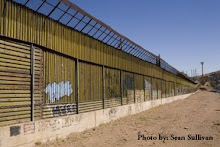By Scott Nicol
If the Border Patrol knocks on your door you might want to have a lawyer present when you answer.
That is because Customs and Border Protection is gearing up for a fresh round of land condemnations to build border walls in Roma, Rio Grande City, and Los Ebanos.
According to documents obtained by the Sierra Club through a Freedom of Information Act request the new walls won’t just slice through farmland and wildlife refuges. In Roma “up to 25 residences could be impacted.” In Rio Grande City the wall’s route will take it through a nursing home, and “If the decision is made to buy the tract out in its entirety, the business will need to be relocated along with 64 residents, potentially up to 90 residents if at 100% capacity.” In Los Ebanos landowners who went through condemnation three years ago will be hauled into court again to have more of their property snatched away.
This new assault on border communities is the result of the US section of the International Boundary Water Commission’s (US IBWC) decision to allow border walls to go up in the Rio Grande floodplain.
When they were first proposed, along with the rest of South Texas’ border walls, US IBWC stated categorically that walls could not be erected in the floodplain because they posed an unacceptable flood risk to communities on both sides of the river. Walls north of the river might deflect rising flood waters, worsening the damage to Mexican cities and possibly even pushing the river into a new channel, thereby changing the location of the international border. For this reason walls in Cameron County were erected north of the flood control levees, and in Hidalgo County there were inserted into them.
The new walls will be identical to those built in Cameron County, using six inch wide steel posts that stand eighteen feet tall with four inch spaces in between. In 2008 Baker Engineering looked at the impacts of this design placed in these locations, and estimated that during a flood the walls would clog with debris, limiting the ability of water to pass between the pillars. In Roma they estimated an 85% blockage where the walls paralleled the river’s flow; in Rio Grande City a 67% blockage; and in Los Ebanos a 36% blockage. Where the walls would be erected perpendicular to the flow Baker said CBP should assume that debris would cause the walls to be completely blocked.
In 2011 Customs and Border Protection paid Baker to look at the same wall design placed in the same location, and with no new evidence or explanation they came to a radically different conclusion. Now “A debris blockage of 10% was adopted where the fence is aligned parallel to the flow and 25% at locations where the fence is aligned perpendicular to the flow.” Not surprisingly the model that this new estimate was plugged into concluded that walls in the floodplain would not deflect or dam flood water, since 75 -90% of the water would supposedly pass right through.
The US section of IBWC accepted this without question. The Mexican section categorically rejected it.
One would think that a bi-national organization would require agreement before permitting potentially dangerous projects. Instead, the new border walls are going up.
In a presentation dated March 1, 2013, Customs and Border Protection laid out a timeline for the construction of these new walls:
Funds: already received.
Achieve right of entry to survey property for wall construction: 60 days.
Initiate new acquisitions of property, through purchase or condemnation: 180 days.
So if you have property in the path of these walls, now is the time to call a lawyer.
And those lawyers are going to be very busy. The “gang of eight” immigration bill includes $1.5 billion for new border walls.
When Congress passed the Secure Fence Act in 2006 Customs and Border Protection walled off big portions of California, Arizona, and New Mexico. There aren’t too many places outside of inaccessible mountains without walls up there. What’s left is Texas.
Unless the bill is changed and the walls are taken out Customs and Border Protection will start filling in the unwalled spaces between South Texas’ existing border walls. The Lower Rio Grande Valley National Wildlife Refuge, and the endangered species that it protects, will be utterly decimated. And every other landowner with property along the Rio Grande from Roma to Boca Chica will stand in turn before a federal judge, before watching construction crews wall off their land from the river.
Some, like the 25 households in Roma or the senior citizens in Rio Grande City, may even see the their homes fall to these new border walls.







